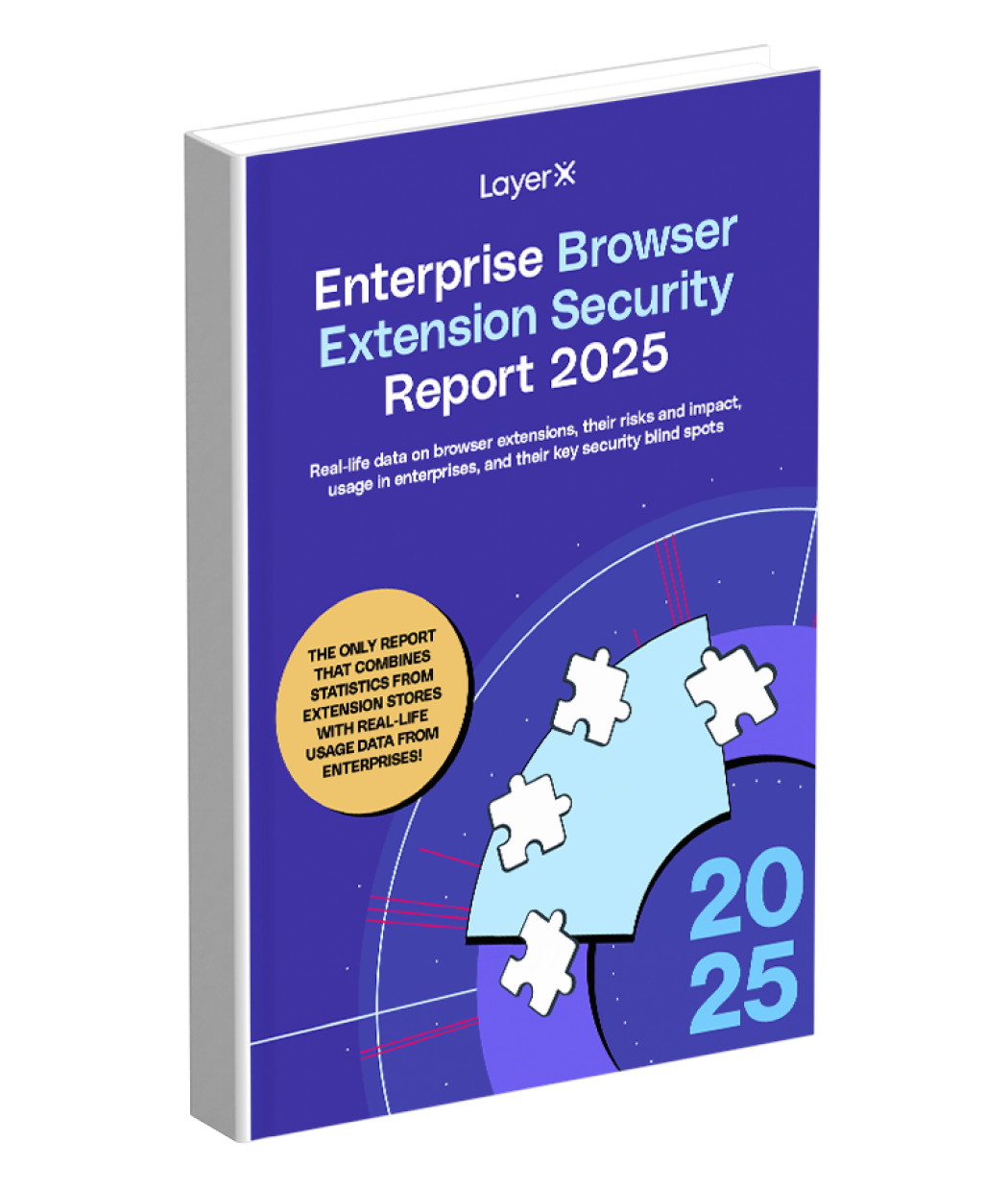Modern enterprises rely heavily on browser-based applications, SaaS platforms, and Gen AI tools for their business success. This makes browsers a central focal point for both organizations and attackers. Attackers seek to compromise the browser to exploit vulnerabilities, exfiltrate data, and compromise sensitive systems.

Enterprise Browser Extension Security Report 2025
Learn More
Protecting Against Malicious Browser Extensions: The Complete Guide
Learn MoreBut what exactly are the browser security threats that can be exploited by attackers, how are they different from network and application risks, and what is required to address them and ensure enterprise browser security? This blog post provides all the answers.
11 Browser Security Threats for Enterprises and How to Mitigate Them
The browser poses security threats to users and enterprises. These enterprise browser threats include:
1. Phishing Attacks
What it is: Phishing is the deceptive use of digital communication to mislead someone into sharing information like access credentials or their credit card numbers. In the context of the browser, attackers create fake login pages, malicious pop-ups, or emails that mimic trusted sources. These are used to trick employees into sharing sensitive information like credentials to SaaS applications or their enterprise accounts.
Impact: Stolen credentials can lead to unauthorized access, exfiltration of sensitive data, financial fraud, and further exploitation of the compromised accounts by moving laterally in the network.
Mitigation: Educate employees about phishing indicators, block suspicious domains and known phishing kits, enforce MFA to mitigate risk even if credentials are compromised, enforce the principle of least privilege, monitor the network for unusual behavior, and automatically block malicious activity.
2. Malicious Browser Extensions
What it is: Users use browser extensions to boost productivity and enhance the user experience. But some apparently benign extensions are malicious. They masquerade as legitimate extensions but actually contain hidden malware or spyware to harvest sensitive information, track browsing behavior, modify web sessions, and more.
Impact: Malicious extensions can lead to data exfiltration, phishing, unauthorized access, and surveillance of enterprise activity.
Mitigation: Implement policies and automated tools to vet and approve extensions and regularly audit installed browser extensions.
3. Drive-by Downloads
What it is: Automated downloads of malware without user consent when visiting a compromised or malicious website. These downloads can install ransomware, trojans, or spyware on enterprise systems.
Impact: Malware infections can lead to data exfiltration, network compromise, and ransom.
Mitigation: Implement automated controls to detect and block unauthorized downloads.
4. Man-in-the-Browser (MITB) Attacks
What it is: Compromising a browser to hijack its communication channel. This is used to manipulate web content, intercept traffic, or alter data entered by users.
Impact: Attackers use MITB to capture credentials, redirect transactions, or hijack sessions. This can lead to unauthorized access to enterprise systems, data manipulation, and data exfiltration.
Mitigation: Deploy real-time anomaly detection, session protection, and context-aware access controls for the browser.
5. Cross-Site Scripting (XSS) Attacks
What is it: Attackers inject malicious scripts into trusted websites. These scripts run in the browsers of users who visit these websites, stealing cookies and session data or impersonating users on SaaS applications.
Impact: Unauthorized access, identity theft, and data leaks from enterprise systems.
Mitigation: Scan and block malicious scripts in real time and encourage secure coding and patching practices for web applications to minimize vulnerabilities.
6. Browser Session Hijacking
What it is: Attackers intercept or steal session cookies, which allows them to impersonate legitimate users and access enterprise systems without credentials.
Impact: Unauthorized access to sensitive applications, data breaches, and impersonation attacks.
Mitigation: Monitor sessions to auto-terminate suspicious activity and enforce HTTPS for secure session communication.
7. Zero-Day Browser Exploits
What it is: Attackers exploit unknown vulnerabilities in browsers before developers can release patches. These exploits often target browsers and browser extensions to install malware or gain unauthorized access.
Impact: Complete system compromise, data breaches, ransomware infections, and potential espionage.
Mitigation: Track real-time threat intelligence feeds, keep browsers and plugins up to date to minimize known vulnerabilities, and monitor user sessions to identify and block suspicious behaviors.
8. Browser Cache Exploits
What it is: Sensitive data stored in the browser cache can be accessed by attackers, especially on shared devices or after a system breach.
Impact: Exposure of sensitive enterprise information, including session cookies and cached forms.
Mitigation: Enforce policies to clear browser caches regularly and use tools to encrypt cached data.
9. Malvertising
What it is: Attackers use malicious advertisements on legitimate websites to redirect users to malicious sites or download malware.
Impact: Drive-by downloads, phishing, and potential browser malware infections.
Mitigation: Use ad-blocking extensions and implement browser monitoring to prevent exposure to harmful ads.
10. Clickjacking
What it is: Invisible frames overlay legitimate buttons, tricking users into performing unintended actions like granting permissions or initiating transactions.
Impact: Unintended data leakage, unauthorized access, and security policy violations.
Mitigation: Enable browser security headers like X-Frame-Options and Content Security Policy (CSP) to prevent clickjacking attacks and monitor browser activity to block malicious elements.
how-layerx-mitigates-browser-security-threats
11. Inadvertent Data Exfiltration to Gen AI or SaaS Apps
What it is: When employees inadvertently share sensitive or proprietary information. For example, paste sensitive data (like code, client information, or trade secrets) into ChatGPT prompts or unauthorized usage of SaaS apps that result in sensitive data being transmitted or stored in untrusted environments.
Impact: Exposure of confidential customer data, intellectual property, or strategic plans.
Mitigation: Train staff about the risks of sharing sensitive information with external platforms. Create strict guidelines for interacting with Gen AI tools and SaaS applications, specifying what data can and cannot be shared. Deploy Gen AI DLP tools to monitor, detect, and block attempts to share sensitive data with untrusted applications.
The Business Impact of Browser Security Threats
The aforementioned risks affect multiple aspects of business operations. The business impact of browser threats includes:
1. Financial Losses
Cyberattacks can disrupt business operations, delay project timelines, and erode customer trust, leading to lost revenue opportunities. In addition, data breaches can lead to significant financial penalties, especially under regulatory frameworks like the GDPR, CCPA, or PCI DSS. Enterprises may also face legal costs from lawsuits filed by affected stakeholders.
2. Compliance Risks
Many regulations require enterprises to implement robust cybersecurity measures to protect sensitive data, and this calls for browser security. For example, browser vulnerabilities exploited by attackers can expose personal data, violating privacy regulations and leading to mandatory breach disclosures. Failure to address vulnerabilities can result in audits, fines, or revocation of certifications.
3. Productivity Loss
Malware infections, such as ransomware or drive-by downloads, can render systems unusable until they are cleaned or restored, causing downtime for employees. Even after cleaning systems, the time spent recovering data, restoring backups, and reconfiguring software diverts resources away from regular business operations, compounding the productivity hit and cost of browser vulnerabilities.
In addition, drive-by downloads might install spyware, slowing down system performance and causing distractions as employees deal with frequent pop-ups or system crashes. Phishing attacks can also lead to compromised credentials, forcing entire teams to reset passwords and verify accounts, further disrupting workflows. These are just a few examples.
4. Brand Reputation Damage
Data breaches undermine confidence in an enterprise’s ability to secure sensitive information. Customers may feel that their personal or financial data is at risk, leading to dissatisfaction and a reluctance to engage with the company in the future. In addition, competitors may seize the opportunity to capitalize on the weakened reputation of the affected enterprise. They can position themselves as more secure alternatives, leveraging marketing campaigns to highlight their robust security measures and attract disillusioned customers.
How LayerX Mitigates Browser Security Threats
LayerX is an all-in-one, agentless security platform that protects enterprises against the most critical GenAI, SaaS, Web, Identity, and Data Leakage risks and threats without any impact on the user experience.
The LayerX solution is deployed as a browser extension supporting all major browsers, meaning that organizations can easily deploy them without making any changes to networking or architecture, and they do not interrupt user productivity or experience.
The LayerX solution covers the following key customer use cases:
- GenAI Security: Map GenAI usage in the organization, discover ‘Shadow’ AI apps, and restrict sharing sensitive data with LLMs
- Browser Extension Protection: Discover all extensions installed in the organization, assess their risk, and block or disable risky extensions
- SaaS Security: Detect ‘shadow’ SaaS apps, apply SaaS security governance, and enforce granular guardrails and block sensitive data from leaking through SaaS apps
- Identity Protection: Protects organizational identities, prevents account takeover attacks, and restrict activity by unsafe identities
- Web/SaaS DLP: Track all data that goes on web-based SaaS and file-sharing apps and enforce controls on file-based and file-less data
- 0-Hour Web Protection: Scans every code element in real-time to stop 0-hour web threats such as phishing, malware, web vulnerabilities, and more
- Secure Remote Access by BYOD / 3rd-Party Contractors: Secure remote access from unmanaged devices and 3rd-party users with a single solution that covers all devices and employees
Here’s how LayerX supports browser security threats:
| Threat | How LayerX Protects | Impact |
| Phishing | LayerX blocks phishing and social engineering web pages and web elements, which are recognized through URL filtering and real-time analysis of page behavior. | Phishing attempts are stopped before users can engage, protecting against exfiltration of sensitive data, stolen credentials, and unauthorized access. |
| Malicious Extensions | LayerX automatically scans and monitors all extensions, preventing risky extensions from accessing sensitive information and threats and blocking or restricting unauthorized extensions based on pre-set policies. | Prevents data theft, session hijacking, and surveillance by ensuring only vetted, safe extensions are used within enterprise browsers. |
| Drive-by Download | LayerX continuously scans web pages for malicious behavior, such as unauthorized code execution or suspicious file downloads. When a potential threat is detected, it proactively blocks the malicious activity, preventing the download from initiating. In addition, LayerX ensures that browsers are always patched and updated, reducing vulnerabilities that drive-by downloads often exploit. | Protects enterprise systems from malware infections, ransomware, and trojans that could otherwise infiltrate through unintentional downloads. |
| Man-in-the-Browser (MITB) | By integrating directly into the browser, LayerX continuously monitors all web sessions at a granular level. This real-time analysis enables the detection of anomalies indicative of MITB activities, such as unexpected script injections or unauthorized data manipulations. In addition, LayerX utilizes sophisticated AI-driven risk engines that operate both within the browser extension and in the cloud. | Malicious actors intercepting and manipulating browser communications to compromise user data and transactions are blocked. |
Cross-Site Scripting (XSS) |
LayerX continuously scans web pages for malicious content, including unauthorized scripts that may indicate an XSS attack. By analyzing web page behavior in real-time, it can detect and block malicious scripts before they execute, preventing potential exploitation. In addition, organizations can implement detailed security policies through LayerX to control browser behaviors. This includes restricting the execution of untrusted scripts and disabling features on web pages that could facilitate XSS attacks. | Protects enterprise applications from data theft, session hijacking, and unauthorized access caused by XSS attacks. |
| Session Hijacking | LayerX continuously monitors browsing sessions to detect early signs of malicious activity. Its AI-powered engine analyzes user activities and web page behaviors to identify anomalies that may indicate session hijacking attempts, like cookie exfiltration. This real-time analysis enables prompt detection and response to potential threats. | Reduces the attack surface and mitigates the risk of session hijacking. |
| Zero-Day Exploits | LayerX dynamically scans every web page and user activity in real-time to detect malicious code, content, and files. This proactive approach enables the identification and blocking of zero-day threats such as phishing attempts and malware before they can impact the user.
Upon detecting a potential threat, LayerX enforces adaptive policies to mitigate risks in real-time. These policies can range from restricting specific user activities and web page behaviors to fully blocking access to malicious sites. |
Prevents data leakage, account takeovers, and other risks. |
| Browser Cache Exploits | LayerX provides real-time protection against web-based attacks on the browser, detecting early signs of malicious activity. | Monitors and controls user activities across web and SaaS applications to prevent data leakage, whether accidental or malicious and auto-terminates hijacked or compromised sessions. |
| Malvertising | LayerX employs an AI-powered analysis engine that dynamically scans every web page in real-time. This proactive scanning detects and blocks malicious code elements, including those embedded in advertisements, before they can execute harmful actions. | Detects and prevents sophisticated attacks that may evade traditional signature-based detection methods. |
| Clickjacking | LayerX’s AI-powered analysis engine, which actively monitors every web page and its individual components, identifies and blocks malicious elements in real-time, ensuring secure browsing. This prevents unauthorized actions that could result from clickjacking attempts. Additionally, LayerX continuously analyzes user activities to detect potential compromises or data loss. | Identifies anomalies indicative of clickjacking attempts, thereby preventing attackers from tricking users into unintended clicks, |
| Data Exfiltration to Gen AI or SaaS Apps | LayerX offers a GenAI Data Loss Prevention (DLP) solution designed to protect sensitive data when using generative AI tools like ChatGPT. This solution integrates seamlessly with existing browsers, providing real-time monitoring and control without disrupting the user experience.
LayerX allows the application of various controls, including pop-up warnings or complete blocking of data entry into GenAI tools. These controls can be activated upon accessing GenAI platforms or when attempting to paste or type sensitive information into their interfaces. |
The solution enables employees to leverage the productivity benefits of GenAI tools while preventing unintentional exposure of sensitive data. |
LayerX supports all common (or uncommon) modern browsers, including Google Chrome, Microsoft Edge, Mozilla Firefox, and any Chromium-based browser such as Brave, Arc, etc., as well as integrates with organizational systems such as IdP, access management systems, SIEM systems, ticketing systems, etc. – to enable easy and seamless deployment.
As a result, LayerX provides key customer benefits, including:
- Full Visibility – Eliminate GenAI/SaaS/Identity Blind Spots: Eliminate security blind spots in the browser and turn any browser into a secure working environment with full visibility & control over identities, accounts, applications, data, and user activity in the browser workspace.
- 100% Enforcement – Comprehensive Protection of the Modern Workspace: Prevent browser-borne risks such as phishing, credential theft, and account takeover, as well as browsing risks such as web/SaaS/GenAI data leakage, unauthorized 3rd-party access, shadow SaaS, and more.
- Zero Disruption— Maintain the User Experience without interruption, without requiring users to change their existing software or workflows, and with no changes to existing network architecture or endpoint software deployment.
- Tamper Proof – Robust anti-tampering measures ensure that LayerX can’t be removed or bypassed by users, with coverage also of Incognito/Private mode, etc.
- Maintain User Privacy – architected for user privacy so that no sensitive information is shared with LayerX, and built-in mechanisms for deep analysis by organizational security managers without compromising user privacy.
